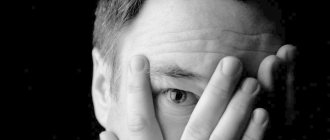Fear of cockroaches is a fairly common disease. The causes may be genetic, psychological, or rooted in childhood. Symptoms of the disease can cause harm to the person who has such a phobia of cockroaches and to others.
The fear of cockroaches is called Blatophobia. A phobia or fear of cockroaches can be debilitating. This is a serious mental disorder, not a whim. An extreme, constant and unreasonable fear of cockroaches can literally turn a sufferer's life into a nightmare.
Reasons for fear of cockroaches
Many people experience discomfort or fear in the presence of insects. Why? Cockroaches are known to inhabit dark and warm places that are abundant with food. Often at night or when there is no light, they accidentally crawl out and scare people. This can cause deep fear or disgust. This disgust reaction comes to us at a genetic level, our prehistoric ancestors were programmed to remain vigilant to these creepy creatures when they slept in caves and in the open air.
There are people who have inherited the gene responsible for Blatophobia, or the fear of cockroaches. Scientists have discovered that mice can pass on information about traumatic experiences to subsequent generations. The reason why people suffer from irrational phobias could also be inherited from the experiences of their ancestors.
A person who is afraid of cockroaches may have had negative or traumatic experiences in the past. Children may have been punished or locked in closets or dark areas infested with cockroaches. They are more likely to develop a cockroach phobia. Adults who express extreme fear at the sight of a cockroach may also unknowingly pass on their fear to children watching them.
Most childhood fears disappear over time. However, in some cases, the phobia may persist into adulthood.
Children come into the world largely fearless and curious about their environment. It is through learning - either based on negative, traumatic experiences, or by imitating the fears of one's parents - that phobias develop. A child who sees people screaming at the sight of a cockroach may not have a balanced reaction to cockroaches.
Negative press about cockroaches crawling into your ears or nose during sleep also does not contribute to a neutral attitude towards insects. Visually, cockroaches are thick, smooth and greasy, which gives us a feeling of natural disgust. Others are afraid of them because they can hide in dark places and crawl out unexpectedly. Still others imagine cockroaches invading their homes, biting them, or spreading disease. For still others, the smell of cockroaches alone can cause nausea.
New fears may arise due to unexpected situations and the person's inability to cope with that particular situation. For example, being trapped in a malfunctioning train or elevator can make an adult feel afraid of confined spaces or feel claustrophobic.
Brief description of the phobia
The sight of a running cockroach when the light suddenly turns on causes disgust and disgust.
Any reasonable person would swat a bug and go to sleep. But there is a special category of people for whom a domestic parasite causes panic. If, at the sight of a beetle, you sweat actively, your breathing quickens and your heart rate goes astray, then we are talking about a mental illness.
People call it fear of cockroaches. The scientific name of the term is blattophobia.
Causes
As a useful mechanism for protecting ancient people from danger, the fear of insects has long been unfounded. But fear of cockroaches does not arise out of nowhere. Everything has its root causes. It is better to look for them in childhood or remember other stressful situations.
An irrational fear of cockroaches arises against the background of:
- Stereotypes of others. A mother panicking at the sight of an insect passes on her fear to her baby. If a child has repeatedly observed an overly emotional reaction, he inevitably begins to fear household pests.
- Excessive disgust. If a person experiences a strong aversion to everything dirty, then the cockroach, as a carrier of infection, will cause negative emotions. In people with a weak psyche, this quickly develops into a phobia.
- Stressful situation. Cockroaches are ubiquitous sneaks. You can hear stories from doctors when a cockroach climbed into a sleeping person’s ear or nose. This is a rather painful condition, and having to go to the hospital for such a problem causes a feeling of great shame. After removing the parasite from the body, fear of cockroaches becomes a natural reaction of the patient.
Often the disease is diagnosed in people who have experienced severe hardships or natural disasters. The need to live in conditions of domestic troubles causes serious stress when you see parasitic insects.
Regardless of the cause of the disease, the symptoms for all people with blattophobia are approximately the same. If there is an excessive reaction specifically to cockroaches, but snakes, spiders or other animals do not cause panic, you can safely diagnose a phobia.
At the sight of one tiny insect, the patient experiences sudden, severe panic. The body reacts to this:
- uncontrolled tremors of the limbs;
- profuse sweating;
- dry mouth and ringing in the ears;
- suffocation and heart rhythm failure;
- dizziness and loss of consciousness.
With a particularly advanced and serious disorder, a person may experience fear of death when seeing a picture of a cockroach, for example on TV. He doesn't know how to stop being afraid of cockroaches or images of them.
Danger
Blattophobia is not nearly as harmless as it might seem at first glance. A large-scale attack causes serious surges in blood pressure and a powerful surge of adrenaline. In some cases, this can lead to paralysis and death.
In everyday life, people with a fear of cockroaches behave irrationally in any situation, which causes serious inconvenience to others. Blattophobes constantly wash their hands and clean surfaces without apparent need.
An exterminator periodically appears in the patient's home and carries out preventive measures where this has long been no longer necessary. As a result, a large amount of personal time, effort and money is spent fighting non-existent beetles. They often do not eat in public or visit friends.
The patient believes that there are cockroaches in any territory not under his control.
As a phobic mental disorder, fear of cockroaches is difficult to treat. With a systematic integrated approach, you can significantly reduce the negative somatic reaction, which will relieve the heart from excessive stress at the moment of panic. How to stop being afraid of cockroaches and help yourself?
The nature of unreasonable fears is very simple - they instantly attack their victim, and just as quickly retreat in the absence of real danger. During your next meeting with a red cockroach or a Prussian, you need to take control of the situation. Deep, even breaths and exhalations, a calm attitude will help you quickly cope with panic and destroy the cockroach.
If you can’t cope with the problem on your own, psychotherapy will be the only reasonable way out of the situation. An experienced psychologist uses the following treatment methods:
- hypnotherapy or programming of human consciousness. During a hypnosis session, work with the subconscious occurs, aimed at completely getting rid of fear;
- neuro-linguistic therapy. In collaboration with a specialist, the patient realizes the destructiveness of his own reaction and reprograms himself to behave normally when he sees a cockroach;
- cognitive therapy. During sessions, an experienced doctor exposes the patient to indirect exposure to insects and teaches them to cope with fear independently.
At the end of treatment, any of the patients can be completely calm near the cockroach and live a full life as a healthy person.
Fear of cockroaches is a very common phobia, and this is understandable: these insects have an unsightly appearance and live in human homes. But if the indicated phenomenon turns into pathological fear, something needs to be done about it, because the resulting panic attacks can end in a completely incomprehensible way. In medical circles, fear of cockroaches is called blattophobia.
We suggest you read: Red cockroach: types, stability, how to reproduce
Etiology of the phenomenon
It happens that a person simply does not like cockroaches and this is normal, i.e. we are not talking about a disease here. Everything can be explained by a banal feeling of disgust, which does not require treatment. In other cases, a person panics at the sight of a mustachioed insect, this already indicates psychological pathology, such people are called blattophobes.
The following factors can provoke the disease:
- Childhood stress. A person, while still a child, could become a participant in a situation in which there were cockroaches. After such an event, negative memories may remain in the memory, provoking fear of insects.
- Hereditary factor. Of course, blattophobia is transmitted at the genetic level, but if a child’s parents experience an uncontrollable fear of insects, then one can most likely expect that the children will also suffer from a similar phobia.
- Children's fairy tales. A child’s wild imagination can draw an evil monster in the form of a cockroach, for example, after reading Chukovsky’s poem “The Cockroach,” because everyone was afraid of this anti-hero in the fairy tale.
- Films featuring scary cockroaches. The modern film industry boasts a huge number of films where the roles of the main characters go to insects. While watching such film projects, a person may form the wrong idea about cockroaches. In such films, small insects are presented as huge destroyers, killing people and destroying everything in their path.
- Repulsive look. Not a single species of cockroach can boast of attractiveness. All of them are disgusting to one degree or another.
- Diseases. Everyone knows that insects can be carriers of various diseases. Among patients with blattophobia, there are many who are simply afraid of catching something from cockroaches. Especially if a person is already sick with something after an insect bite.
You can say that a person has blattophobia if the following symptoms appear:
- Panic attacks. The person who saw the insect begins to become hysterical. His brain stops adequately assessing the situation. For example, a woman may scream loudly or jump onto a chair or other elevated surface.
- Unpredictable actions. A person with blattophobia understands perfectly well that at the moment of meeting a cockroach his actions are inadequate, but he cannot do anything about it. With his actions, he can shock his surroundings if people are accustomed to seeing the blattophobe as a reasonable person. Patients with this phobia constantly purchase various poisons to treat their apartment, even if there were no cockroaches at home.
- Pathological feeling of fear. The appearance of a blattophobe gives him away when insects appear: he begins to tremble in his knees, sweat profusely, stutter, and he suddenly turns pale.
- Excessive feeling of disgust. Moreover, it may not appear at the sight of all unsightly insects or animals.
All of the above-mentioned manifestations of fear of cockroaches, like other phobias, prevent the patient from living a full life.
Principles of treatment
Blatophobia is a complex disease characterized by the fact that it is difficult to treat. Of course, you can be afraid, but is there a way to hide it from others all your life? If a person approaches this issue responsibly, treatment may take a very short period of time.
Psychological problems often require medication; in the case of fear of cockroaches, the following may be prescribed:
- Tricyclic antidepressants. They activate neurotransmitters - substances through which impulses are transmitted from a nerve cell through the synaptic space between neurons. Such drugs include Sertraline, Moclobemide or Fluoxetine.
- Benzodiazepines. Such drugs are classified as weak tranquilizers, they are taken directly during panic fear - Phenazepam, Imipramine, etc.
- Beta blockers. Usually used for the treatment of cardiac pathologies. But as you know, stress can provoke problems in this particular system of the human body, i.e. complex treatment should include these drugs.
- Psycholeptic drugs. Such drugs block the feeling of increased anxiety during an encounter with an insect. Buspirone is usually prescribed for blattophobia.
Taking medications will not completely eliminate fear. Medicines can help only temporarily, directly during a panic attack. Therefore, you often cannot do without the help of a psychotherapist:
- A virtual reality. In order to carry out treatment with this method, it is necessary to create a situation for the patient in which he will be close to the object of his fears, but will feel safe. Blattophobe puts on a virtual reality helmet and watches a video in a three-dimensional projection in which cockroaches are present, but they are just an element of a computer program.
- Hypnosis. Any phobia can be overcome in this way: the doctor puts the patient into a trance state and, by asking questions, reveals the true cause of the fears. However, few people decide to undergo such a procedure, all because of the same fear.
- The method of neurolinguistic programming is capable of revealing all the nuances of the reality in which the patient has placed his consciousness. During an NLP session, a new model of perception of the surrounding world is created: a kind of brain reboot occurs.
- Simulation of situations. After identifying the etiology of fear, the psychotherapist, simulating various situations, teaches the patient how to behave in them, suppressing panic.
We suggest you read: What kind of eyes does a cockroach have?
Manifestations of fear of cockroaches in humans
Symptoms of Blatophobia vary from person to person, depending on their personality characteristics and state of mind. Additionally, patients with cockroach phobia may have any number of triggers, from actual live cockroaches to a simple photograph. The severity of symptoms depends on the person's level of fear.
Typically, symptoms of Blattophobia include an extreme fear of cockroaches and simply a feeling of discomfort or anxiety when exposed to cockroaches or any environment in which they may live.
If the level of fear is high enough, exposure may cause a panic attack. Panic attacks are heightened levels of fear and anxiety during which a person experiences a variety of physical symptoms. These symptoms include rapid heartbeat, difficulty breathing, weakness, fainting, dizziness, tingling or numbness in the arms, extreme feelings of dread, loss of control, and chest pain.
The danger of blattophobia
Fear of cockroaches often leads to obsessive-compulsive disorder. The panicker tries to thoroughly clean his house to prevent these creatures from appearing. Constantly spraying insecticides in the home and car, sweeping and cleaning carpets and rugs, and cleaning kitchens and bathrooms, etc. to deter cockroaches are some signs of Blattophobia.
Blattophobia can sometimes get out of control or become dangerous not only for the person, but also for others, when a frightened person in a state of passion runs out onto the road or tries to drive away a cockroach while driving a car. All this can lead to serious accidents.
Ways to fight the disease
Psychological treatment aims to reduce the level of vigilance in the presence of a cockroach and reduce negative feelings, thereby suppressing the repetitive behaviors that make cockroaches a phobia.
The stages of treatment will be as follows:
- Know the enemy. The doctor invites the patient to jointly study the characteristics of cockroaches: species, origin, morphology, significance, reproduction, etc. As if this were a scientific study. It is important to focus on the facts and avoid photographs, videos or direct contact with cockroaches, which can be very difficult for the patient at this early stage.
- Mastering fear. In this study of cockroaches, the psychologist helps the patient to tame fear using the scary fantasy technique, which is similar to learning how to increase fear to reduce it to nothing. Continuing home practice is important to make it a pragmatic and realistic tool in the context where a cockroach may appear
- Measure your limits. In the third stage, the doctor tests the distance a person can approach the cockroach without fear, and notes how these limits change during the treatment.
- Warning about possible relapses. A psychologist explains to a patient who has just overcome his phobia that repeating old behaviors can cause a relapse and trigger the phobia again.
During treatment, the doctor constantly draws the patient's attention to the diminishing sense of danger in front of the cockroach, which turns into a feeling of calm and turns him into a freer and more confident person.
Methods for dealing with phobias
Taking your fear of cockroaches for granted is not a solution to the problem, but a self-defeating escape attempt. Fear destroys a person's life, and it takes a lot of effort to become the master of your fear, and not remain a prisoner. Accept the problem, understand it and start fighting using an integrated approach. Cockroach phobia can be treated using psychotherapy or medication.
Drug treatment
Medicines are prescribed exclusively by a doctor. Self-treatment can lead to serious consequences.
The list of medications below is for informational purposes only.
- Tricyclic antidepressants (Fluoxetine, Sertraline).
- Weak tranquilizers (Phenazepam, Imipramine). They must be used directly during panic attacks.
- Tablets that block the feeling of increased anxiety during an encounter with an insect. These include Buspirone.
But medications can only help temporarily, directly during a panic attack, when the patient needs to be calmed down by giving a soothing decoction or pills.
Medicines must be taken as prescribed
Other methods to get rid of the problem
The main assistance in the fight against blattophobia can be provided by qualified psychotherapists or psychiatrists. They will teach you how not to succumb to phobias and reduce the negative impact of stress on the body. Treatment for each individual is selected individually, as it depends on many factors.
- Hypnosis is a state in which suggestibility increases and the absence of fear of a phobia is imprinted in the subconscious. Not all patients will agree to this method of treatment, all because of the same fear, but all phobias can be treated with hypnosis. The doctor puts the patient into a trance and, asking him leading questions, determines the true cause of fear.
Hypnosis against phobias
- The method of autogenic training consists in mastering the technique of self-hypnosis, in which a feeling of heaviness arises in the body, as a result of which a state of muscle relaxation is achieved, the so-called. relaxation. To do this, you need to turn on calm music, relax, even out your breathing, turn off your emotions, close your eyes and start saying self-hypnosis phrases: “I am brave.” I easily overcome my fear”, “I know that my fear is created by me, which means I can overcome it”, “I turn off my fear of (cockroaches) for the whole day.”
- The practice of yoga is a good helper in the fight against phobias. Regular yoga classes provide an outlet for our fears, gradually eliminating the level of anxiety.
- One of the effective techniques in struggle is to face your fear. By overcoming yourself, you will overcome your phobia. The exit should not be rapid, but gradual.
- Playing sports in the fresh air is a cure for many diseases, including blattophobia.
Look fear in the eyes
- Fear is a basic and healthy human response necessary for survival, making us aware of danger and therefore aiding our defense.
- If you repeatedly avoid what you fear, then fear turns into terror and phobia, causing the need for extreme protection, which manifests itself in an even greater than expected physical reaction to the real danger of the feared object.
- Thus, the phobia limits and paralyzes when in contact with a cockroach, but outside this space a person can live normally.
- In fact, people with a phobia often endure it for a long time until they decide to undergo psychological treatment and eradicate it. They maintain a reasonable level of life satisfaction, usually do not suffer from any other psychological disorders, are generally very good at organizing and asking family for help in avoiding their phobia, and may go unnoticed by an outside observer.
- Cases of a phobia of cockroaches in the event that it suddenly seemed to him that a cockroach was running across the table in the kitchen. Then the sufferer increases his vigilance and implements a number of precautions and evasion measures from the enemy.
- Active preventive extermination begins with the help of professionals, insecticides are sprayed at home and traps are placed throughout the house. At night, he moves the bed away from the curtains, the bedspreads do not touch the floor, systematically avoids garages, goes out onto balconies when night falls, since any movement on the floor or clothes can be a cockroach.
- When faced with cockroach phobia, psychotherapy treatment is very effective. The treatment algorithm is described above.
- By overcoming your phobia, you can free your children from suffering because phobias are unconsciously copied.
Causes
Negative experience
A phobic disorder also appears in the event of an unpleasant situation associated with this pest.
Let's say a person wakes up in the middle of the night because a Prussian dog is climbing on him. This, in addition to being scary, is also disgusting. Such an incident is truly memorable for a lifetime.
mass media
Modern cinema is rich in horrors involving various insects. If an impressionable person watches, for example, “The House with Cockroaches”, “Human Eaters”, “Invasion of Cockroaches” and other films, then this may well provoke the development of blattophobia in her.
Moreover, if this happened in childhood, when the child’s psyche is not yet able to cope with information that is difficult to perceive.
If he can easily be traumatized by Chukovsky’s “Cockroach,” then what can we say about horror films.
Upbringing
If mom or dad suffer from blattophobia, or are simply afraid of insects, then it is likely that the child will repeat their style of behavior and reactions.
Especially if the parents talk about how dangerous and unpredictable animals they are.
Infection
If a person is afraid of becoming infected with diphtheria, tuberculosis, leprosy, or even just “catch” worms, he will be critical of everything that surrounds him.
And understanding that Prussians are the source of these infections, obsessions about their presence in his home will literally drive him crazy.
Serious form of disorder
More severe forms of phobia occur. Some doctors are of the opinion that in most cases phobia is not a disease, others are convinced that it is a symptom of a mental disorder.
In any case, the fear, anxiety or fear experienced by people suffering from this condition is different from the natural anxiety experienced by ordinary people.
And if fear is a normal psychological reaction that occurs in response to a situation of real danger or threat, then phobia is a state that does not follow rational logic, and the feeling in these situations does not correspond to the danger that it actually poses.
A phobia can vary in duration, cause physical and psychological reactions, and seriously impair quality of life.
Alternative medicine for treating insect fear
Treatment is tailored differently to different people. What works best for one person may not work at all for another. However, there are several more common treatments for phobias.
Therapy is always a great first step. Several types of therapy allow both the individual and the psychologist to better understand the root of the inappropriate response to cockroaches, which makes treatment much easier.
Cognitive behavioral therapy, for example, is designed for this purpose. It helps alleviate fear by changing the way a person thinks about cockroaches.
Shock or contact therapy is also beneficial because it desensitizes a person to cockroaches. Gradual desensitization or exposure therapy is one of the most common methods of overcoming zoophobias such as Blattophobia. This includes seeing pictures of cockroaches, touching a dead cockroach, and returning to the room with the cockroaches without having a panic attack.
Medication is also helpful for those who experience severe anxiety in situations where cockroaches are or may be present. Specially formulated anti-anxiety medications, or antidepressants, work well for this. They are also useful during panic attacks. For those who are allergic to cockroaches, allergy medications may also help.
The good news for people with an extreme fear of cockroaches is that the phobia can be overcome.
Hypnotherapy is another effective way to overcome Blatophobia. This can help the patient understand the fear and change their thoughts about cockroaches.
Manifestations and signs of blattophobia
Cockroach phobia has four characteristic manifestations:
- irrational actions (frequent disinfestation of the house, frequent hand washing, attempts to destroy cockroaches by any means);
- obsessive ideas and thoughts (about killer cockroaches, about contamination of food, about insects entering the human body at night);
- vegetative signs (tachycardia, sweating, breathing problems, dizziness, nausea, trembling);
- panic at the sight of an object of fear (screams, sudden movements of hands, running or jumping, etc.).
Some people fall into a stupor when they see a cockroach, others begin to cry, others try to escape (they may run out of the house). If a person thinks that an insect has crawled into his ear, the blattophobe will run to the hospital or try to get (poison) the insect himself. The latter is very dangerous, because in a state of panic a person can harm himself.











